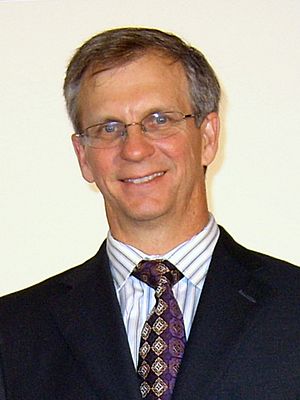Alan Eustace facts for kids
Quick facts for kids
Alan Eustace
|
|
|---|---|

Eustace in 2008
|
|
| Born |
Robert Alan Eustace
December 19, 1956 |
| Alma mater | University of Central Florida |
| Occupation | Computer scientist |
| Known for | World record for the highest-altitude free-fall jump |
| Board member of | Anita Borg Institute for Women and Technology |
Robert Alan Eustace, born on December 19, 1956, is an American computer scientist. He is widely known for his incredible free-fall jump from the stratosphere on October 24, 2014. This amazing feat broke the previous world record held by Felix Baumgartner. Eustace jumped from an altitude of 135,890 feet (41.42 km), setting a new record that still stands today. He also had a very important career at Google, where he worked as a senior leader in engineering until he retired in 2015. In 2015, he received the Laureus World Sports Award for Action Sportsperson of the Year for his record-breaking jump.
Contents
Early Life and Education
Alan Eustace grew up in Pine Hills, Florida, a neighborhood near Orlando. His father was an engineer, and many families in their area worked for a company called Martin Marietta. After finishing Maynard Evans High School in 1974, Alan received a scholarship to study debate at Valencia College. He attended Valencia for a year before moving to the University of Central Florida, which was then known as Florida Technological University. He first studied mechanical engineering.
While in college, Alan had a fun part-time job at Walt Disney World. He sold popcorn and ice cream in Fantasyland and even worked on the monorail! He later took a class in computer science and found it so interesting that he decided to change his major. He went on to earn three degrees in computer science, including a doctorate in 1984.
Career in Technology
After finishing his studies, Alan Eustace worked for a few technology companies. He started at a new company in Silicon Valley called Silicon Solutions. Later, he joined Digital, Compaq, and then HP's Western Research Laboratory. For 15 years at HP, he worked on many different areas of computer technology. This included making computers smaller, improving how computer chips work, and managing power use in devices.
In 1999, Alan became the head of HP's Western Research Laboratory. Three years later, he left HP to join Google, which was a much newer company at the time. At Google, he became a Senior Vice President of Engineering. He played a key role in developing many of the technologies we use today. He retired from Google in March 2015.
Today, Alan Eustace works as a Technical Advisor at Opener Aerospace. He sometimes talks about their electric VTOL aircraft, which is a type of aircraft that can take off and land vertically, like a helicopter. Throughout his career, Alan has helped write nine important papers and holds 10 patents for his inventions.
The Record-Breaking Jump
In 2011, Alan Eustace decided he wanted to try something extraordinary: a jump from the edge of space, known as a stratosphere jump. He teamed up with Taber MacCallum, who was one of the founders of Biosphere 2. Over the next three years, a special team from Paragon Space Development helped Alan design and build his unique parachute and life-support system. This amazing project was called the Stratospheric Explorer mission, or StratEx Space Dive.
Preparing for the Jump
Alan's team worked hard to create a special suit that would protect him in the extreme conditions of the stratosphere. Unlike Felix Baumgartner, who jumped from a capsule, Alan Eustace planned to hang directly beneath a giant balloon in his custom-made pressure suit. This suit was designed to keep him safe and warm in the very cold and thin air high above Earth.

On October 24, 2014, everything was ready. Alan began his ascent early in the morning from an old runway in Roswell, New Mexico. He was carried up by a huge gas balloon made in India. The balloon slowly lifted him higher and higher into the sky.
The Historic Descent
Alan Eustace reached an incredible height of 135,889.108 feet (41.419000 km; 25.7365735 mi). This was higher than anyone had ever jumped before! To begin his descent, he used a small explosive device to separate himself from the helium balloon.
His freefall descent lasted 4 minutes and 27 seconds. During this time, he traveled nearly 26 miles (42 km) and reached incredible speeds of over 822 miles per hour (1,323 km/h). This set new world records for the highest free-fall jump and the longest free-fall distance, which was 123,414 feet (37.617 km; 23.3739 mi). The entire journey back to Earth, including the parachute ride, took about 15 minutes.
It's important to know that Alan's jump involved a special small parachute called a drogue parachute to help stabilize his fall, while Felix Baumgartner's jump did not. Because of this difference, their records for vertical speed and free-fall distance are kept in separate categories. Before this jump, Alan Eustace was a pilot, but he wasn't widely known as someone who did dangerous stunts. His record-breaking jump was even featured on STEM in 30, a TV show for middle school students by the National Air and Space Museum.
See also
- Space diving
- Yevgeni Andreyev
- Felix Baumgartner
- Joseph Kittinger
- Nick Piantanida
- Cheryl Stearns
- Steve Truglia
- Olav Zipser
- Victor Prather


